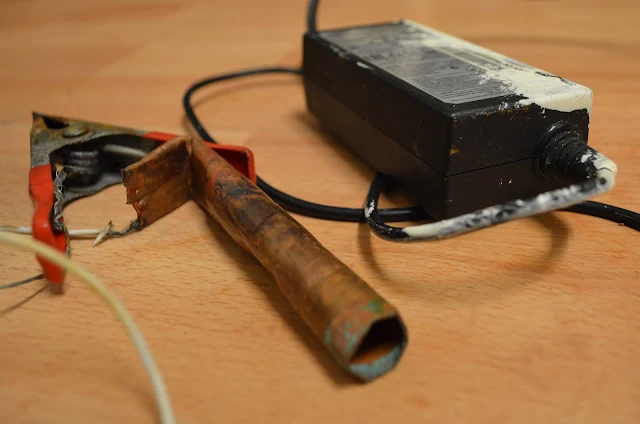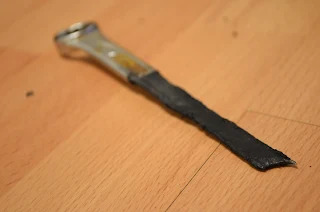Iron oxide (Fe2O3) can easily be made through electrolysis. The basic idea is to pass a current through water with iron electrodes. The water splits into hydrogen and oxygen. The oxygen then binds to the iron electrode, turning the Fe2+ into the iron oxide. This method produces very red iron oxide, with an oxidation state of 3+.
Firstly, you will need a power supply, which is the most inaccessible aspect of this project. I used an old laptop power supply, with the ends connected a large clip and a piece of old pipe. This produced 19V at 3 amps, which is more than enough.
The next issue is that water is not conductive. To combat this, I used table salt, though some people do not like to use this as a by-product of the reaction is chlorine. Because of this, I only ran this experiment in a well ventilated attic.
I used a large plastic bucket to perform this experiment. It is important that the bucket itself is not conductive, or it will short out the current, and no power will actually go through the water. Next, I filled it a quarter of the way up with a slightly dilute salt water solution. It is important to note than more salt will mean a faster reaction time, but will make the purification step longer, and will possibly include a larger salt contamination in the final product.
The bucket is dirty because I have used it before for this project, but the damage is purely cosmetic and can be wiped off.
Next the electrodes are placed inside in a way that they do not touch, or short. Then the power can be applied, and you should see and hear a large amount of small bubbles. This is the release of oxygen and mostly hydrogen. If you used salt as an electrolyte, there will also be a thin white-green haze of chlorine, so do not breathe this in.
I left this apparatus on my windowsill for 24 hours, and constantly checked the power supply to make sure it did not get too warm. I highly recommend that you do not leave this on overnight - the 24 hour period was stretched over 3 days. You will see that most of the bubbles emanate from only one electrode, which is normal - this is the cathode, and since there is twice as much hydrogen as oxygen in water, there will be twice as much bubbling on this electrode.
Over time, the other electrode should start to disappear. There will be a sludge forming on it as well, and I regularly scraped this off while it formed to allow the current to pass easier.
After a few hours, a layer of conductive sludge settled to the bottom of the can. This started to short circuit the electrodes, so I had to raise them in order to make sure that the current was only passing through the salt water. A good rule of thumb is if there is no bubbling, then nothing is happening.
I prefer to decant the water on the top, to allow the filtration to be faster. The remains can then be poured into the filter bit by bit. After most of the salt water has drained, you will be left by a thick, green sludge, which looks nothing like the red iron oxide that this experiment produces. This is because this sludge is almost entirely a mixture of Iron (II) oxide.
To turn this sludge into Iron (III) oxide, it must be heated, to primarily allow the sludge to oxidise from 2+ to 3+, and to allow the water to evaporate, leaving you with a red crust. This can be done by first collecting the sludge left in the filter with a spoon. This can then be spread on a large metal surface - I used the lid of a biscuit tin.

















